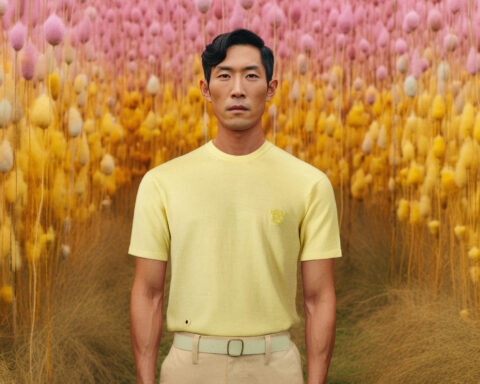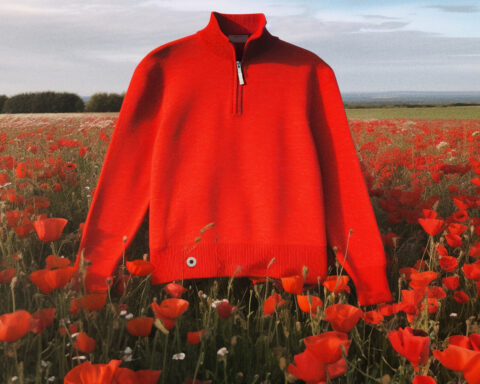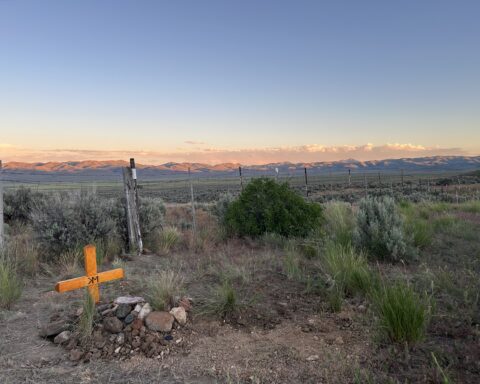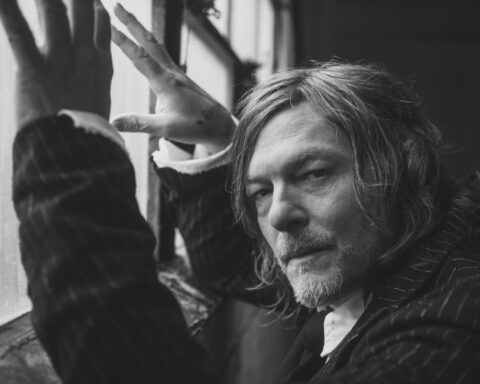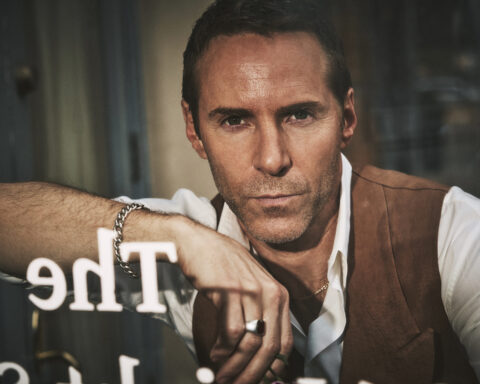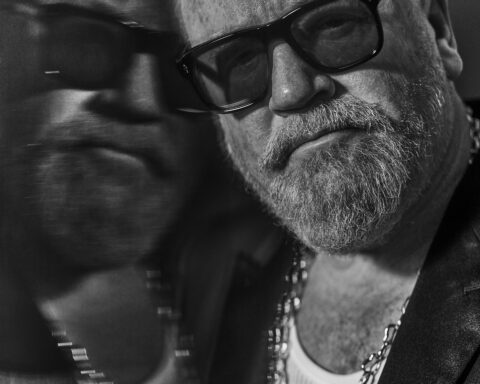Even if the name Paul Cavaco is not familiar, once you see the body of work created by this legendary stylist, you will realize his discerning eye has been presiding over many of the most famous photographs seen through four decades of fashion history.
New York born and raised, Cavaco’s career began when he met stylist Kezia Keeble. They founded a styling firm, Keeble & Cavaco, in 1976, which became the powerhouse public relations agency Keeble, Cavaco & Duka (now KCD) in 1983, when they partnered with New York Times fashion writer John Duka.
Cavaco left the firm in 1992 to make the move into editorial styling, and over the next 25 years he was fashion director at Bazaar, then jumped to the same position at Vogue, finally landing as creative director of beauty magazine Allure for 16 years.
Collaborating with some of the most noted photographers of our time including Richard Avedon, Steven Meisel, Annie Leibovitz and Bruce Weber, Cavaco’s resume is an endless list of timeless magazine images and memorable advertising campaigns for designers such as Calvin Klein, Michael Kors, Versace and Dior.
He was also the stylist for Madonna’s infamous ‘Sex Book’, and although he claims not to care much for working with celebrities, they regularly clamor for his skills, adding such names as Whitney Houston, Rihanna and Margot Robbie to his roster of A-list collaborators.
Here, our co-founder John Pearson, who first met Cavaco on a shoot in the early 90s, and our head of creative Alison Edmond, a fellow stylist, chat with Paul about his life, his rule-breaking, being happiest behind the scenes, and the stories behind the most fascinating of those photographs.

Paul in the 1970’s // 📸: Bruce Weber
John:
Can you explain your background, where you are from and how you ended up in the fashion business?
Paul:
I’m originally from the Bronx in New York City. I’m from Hunts Point, it’s called ‘Fort Apache’. So I’m from this really terrible neighborhood, but I thought it was heaven. I didn’t realize it was bad. Then we moved out of there because, well, it’s junkies and hookers essentially. We moved to Queens and then I went to a normal public school (laughs).
My dad owned a bodega, which is a Spanish grocery store. And then he worked at my uncle’s chorizo factory. My dad’s American and my mom’s American, but his family’s from Spain and my mom’s family is from Cuba.
Then I went to school in the city, in Manhattan, to CCNY, City College of New York. It’s a public school. It cost me $50 to go to college, but I still had to work full-time to pay for my books.

Kezia Keeble, Paul, and their daughter Cayli
I met Kezia Keeble at a Buddhist meeting. We lived together for a while. We had a baby, we got married. She had been an editor under Diana Vreeland at Vogue. Then she left and did a jewelry company. Then she did a PR company [which became Keeble, Cavaco & Duka]. I used to come in — I was a waiter at that point — and wrote the press releases because I thought I wanted to be a writer. I have a degree in English and thought, “Oh, I’ll be a writer because then I don’t have to see anyone!” I am very interested in people not seeing me, which is why fashion was perfect. I was behind the scenes.
But anyway, I wrote this press release and Annie Flanders, who had started Soho Weekly News and later started Details, called up and said, “This is the first press release I’ve read that doesn’t have any bulls**t.” She said, “I’m looking for people to do menswear styling for the Soho Weekly News.” So we did menswear for her and our first shoot was with [photographer] Bruce Weber.
We started to style because Kezia had been one of the sittings editors under Mrs Vreeland. She was a really good sittings editor. Maybe one of the best still, when I look at the work. She was one of the first freelance people at Vogue in the 70s. I was one of the first male editors. There was me, Freddie Leiba and Robert Turner, who did sittings. There weren’t many of us.

(L) Jessica Lange and Sam Shepard, styled by Paul // 📸: Bruce Weber // (R) Model Jeff Aquilon, styled by Paul // 📸: Bruce Weber
Alison:
And sittings editors meant doing the styling as well in those days.
Paul:
It comes from the fact that when Vogue first began and they only photographed very rich women — they didn’t photograph models — they would sit for a photograph the same way you sat for a portrait.
The thing is, we were trained as editors. When I started, there was no-one to do props. So I did it. And eventually when you worked at a magazine, the assistants did your props for you.
I remember one of the first shoots I did with [photographer] Steven Meisel, for Vogue Italia. I would do the props. I thought it was heaven. It was just part of what we did. It was part of conceiving with the photographer. I wish it was back to that sort of simplicity. Where the photographer was the lead, not the art director. Where it came from a collaboration of the [fashion] editor and the photographer to start with. Nobody was in the studio with us. There was no art director. There was no editor. Everything was just trust. And if it didn’t work out, it didn’t work out.

Sofia Coppola, styled by Paul // 📸: Steven Meisel
John:
How did you make the switch from PR to styling?
Paul:
Well, I didn’t ever do the PR. Kezia was doing it. Someone called her to do something for Esquire. And she said, “I can do it for you.” I didn’t know anything about shoots.
It was with college students and Bruce Weber was going to shoot it. I had just gotten out of college, so he ended up using me as one of the guys. Every one of them was six feet tall and I was five feet five, on a good day! And there’s nothing about me that looks like a Bruce Weber model, in any way, shape or form. But I thought, “Oh my God, someone thinks I’m great looking.”
So I take this job as a model and I’m the joke, I’m sort of the foil of the photograph. I’m the person who has to wear glasses throughout the whole thing. Everyone’s looking very normal and I’m laughing. And I kind of laugh like a Doberman. They’re carrying, at one point, clarinets and trumpets. I’m carrying a giant bass fiddle. Everything is meant to make me look smaller and crazy. But I started to put the clothes together with Bruce and Kezia. Then he said, “I think he’s really good.” And he began hiring me to style his ads, and that’s how it started. I’m 24, so Bruce is 29 maybe. He’d really just started too.
But I stopped working in the early 80s. I didn’t want to travel anymore because Cayli, my daughter, was growing up. I realized, I’m either going to watch my daughter grow up or not, you know? No-one would think that one would make that choice. Prada or stay home with my family? I think it’s really hard to be separated from your family for that length of time. So I made a choice, which for me was the right choice.
Then I came back, right when I met you John. Steven Meisel made me come back. Fortunately at that time too, Steven did studio and didn’t like to travel. When I met Steven, he was still illustrating. He was fabulous. The most fabulous person to work with.
It made a lot of people angry that I had stopped and so I couldn’t go back to work. Steven said to me, “Come back to work, we won’t put your name on the page. We will tell everyone they can’t talk about that you’re here on set.”

(L) Model Linda Evangelista, styled by Paul // 📸: David Sims // (R) Models Benedicte and Cecelia Chancellor with designer Marc Jacobs, styled by Paul // 📸: Patrick Demarchelier
John:
Who are your mentors then? Would you call Steven a mentor or Bruce a mentor?
Paul:
Yeah, strangely enough, even though Steven’s more like my contemporary, I learnt a f***load off him. He and Bruce are probably two of the best stylists in the world. They know how to look at photographs. So you get taught to look at pictures.
Kezia really was my mentor. I know this is going to sound so crazy, but she taught me how to tie bows, how to tie shoes, how to pin clothes, things that you had to learn how to do. We didn’t have assistants. She taught me all the rules and then once you learned the rules, you could learn how to break them.
And I think that’s the big difference to today. We had to learn how to handle clothes, how you hold a handbag, how you turn a skirt up. There was no tailor on the shoots. We did it all.

(L) Lucas Hedges, styled by Paul // 📸: Bruce Weber // (R) Model Jean Campbell, styled by Paul // 📸: Bruce Weber
John:
Was there anyone else who influenced you?
Paul:
So the first three photographers I worked with were Bruce Weber, Patrick Demarchelier and Dick Avedon. I did Versace’s first ever ads, I didn’t really know who he was. It was with the famous model Gia, her first shoot with Avedon. It was with all the 70s supermodels.
The one person I was dying to work with was [photographer] Irving Penn, who I did finally work with. I was told that I had to be quiet in the studio, that was the advice given to me. Obviously I’m not very quiet and I’m Latin, so I’m a little bit loud and I think everything is funny. So we’re in the studio and it’s again for Versace. It’s Christy Turlington, Linda Evangelista, Yasmeen Ghauri. It’s Oribe on hair, and Kevin O’Connor, and then it becomes Francois [Nars] on makeup at a certain point. So it’s everyone I grew up with and we were laughing. The dressing room is probably the size of this tiny room I’m in right now. So you’re all jammed in there, which is how you like to be anyway, that was the fun, all the time with the hair and makeup people and the models, you became a family.
So Penn came in and we were laughing, I thought, “Oh f***, he’s going to be so mad.” And he just came in and said, “It’s been so long since I’ve heard laughter in here,” and he immediately started to talk to me. I was leaving our company [Keeble, Cavaco & Duka] and going to Bazaar and it had just come out in the papers. He came in with it and said, “Oh, look what I read about you.” Then his wife passed away, my daughter’s mother passed away, and he would ask me questions about that. He was the one I was dying to work with, and we got to do a few things together.

Paul Cavaco // 📸: Kurt Iswarienko
Alison:
Can you explain to people what editorial stylists do, as I think it’s often misunderstood as just doing up buttons and zips.
Paul:
What we are is invisible. When you look at the photograph, you’re not supposed to think, “Oh, someone manipulated it.” You are supposed to look at it and think, “Oh, that’s how the person is dressed. That’s their clothes.” They should look like they fit the clothes. It should look like they fit in whatever sort of situation they’re in, even if it’s the studio. I think that people don’t know that we have this invisible hand, but we’re also looking at everything. Everything makes a difference. Every decision that you make, what color the lipstick is going to be, whether or not to use lipstick, whether to take an eyebrow out, all those things make the picture, it’s a collaboration. All of those decisions. Those are the decisions we make and that’s what sort of gives the style to the picture.
John:
Did you like the word stylist, the label of stylist?
Paul:
I don’t really care because I started as one. But I don’t want to be called ‘wardrobe.’ I never did commercials, but I finally did one very late in my career, a few years ago, and they started to call me and they kept saying “wardrobe” and I had no idea. Someone said, “They’re calling.” I said, but I don’t hear my name and they said, “No, ‘wardrobe’ — you’ll have to respond.” We do have names! You can call me by my name.

David Bowie and mannequin, styled by Paul, at right // 📸: Greg Gorman
John:
How important is the team around you when you work with the photographer, the glam, the model?
Paul:
That is the only word I really hate, ‘glam.’ I hate ‘the glam squad’ label because we are whatever we do, hair stylist, makeup artist, editor, or stylist. It’s not glam because sometimes it’s not glamorous. It’s lumping us into this little troop.
There is a hierarchy. I mean, the photographer is always the top person. It’s a photograph. But the thing is, if the model is not collaborative, if you’re not allowing them to be part of the process, you’re also missing out — because that’s who you’re taking the picture of.
I think people think, “Oh the model just gets dressed and goes on set and looks beautiful.” Try to take a picture of yourself, try to do a f***ing selfie! Try being in front of a camera where there’s people staring at you as you try to perform. You can’t.
I’ve seen people actually walk over to the model, take their hand and move it from from here to here. They can move their hands! They’re fully automated. As if you, as the model, aren’t creating. I think that’s the thing that people don’t realize, if you’re a good model, everything is working. Your feet are working. Your hands are working. Your nostrils are working.
We’re all creating, it is this collaborative thing and I think people leave out the model. It’s like the minute someone finds out you’re a model, you might as well just have had a lobotomy and just be wheeled around by someone. They have no idea what it actually takes, because in all the pictures we love, you can be sure that the model was fully participating. If a model is not there you can see it in their eyes. The reason someone like Peter Lindbergh was such a beautiful photographer is you saw the person’s life in their face.
People think I’m as dumb as a doorknob because I’m in fashion. If I tell someone I’m in fashion, I can see them go like, “Oh God”. They say, “What do you do?” Well, I dress models and they’re thinking, “Oh, this is like a guy who plays with dolls all day.”

(L) Oprah Winfrey, styled by Paul // 📸: Steven Meisel // (R) Margot Robbie // 📸: Chris Colls
Alison:
How do you find our work differs on celebrity shoots, because obviously that’s quite a different thing?
Paul:
I think what’s different, what’s hard about the celebrity shoot, is there’s always a decision to be made. Are they going to be a character or are you photographing them as themselves? And a lot of times they don’t do their research. If I was going to be photographed by somebody, you’d be damn sure I would. I’m sure they don’t walk into the movie set, not knowing who the director is, not having read the script. How do you walk onto a set and not know that the person who’s styling you has a certain style?
When we worked at Bazaar, I told Liz [Tilberis, the editor] I didn’t want to do any celebrities. This was before the start of celebrities [on covers]. The first one we did was Daryl Hannah and I was like no, Tonne [Goodman, co-fashion director] is doing it. And then of course I met her, she came up to the office with Tonne and Peter, [Lindbergh] and she was lovely. I thought, “Oh, I should have done that shoot but Tonne got it.”
The one I wanted to do was Whitney Houston. She was about to come out with her first movie. I got obsessed and that’s the only one I wanted to do. Then I said yes to Liz, we can do Whitney!
The reason I didn’t want to do celebrities was because I couldn’t figure out what to do with them, because I’d like them as they were. I liked it like Life magazine, you see their life.
The reason models work so well is because they know what to do. They’re also not afraid to be a fool. Where as an actor will be fearless in front of a movie camera, but maybe not so fearless [doing stills]. I find it difficult. I’ve done a lot of celebrities obviously and usually it always ends up fine. But it’s a harder thing, because if it’s a model, you can just say “put this on.” If they look shitty in it, they know I’m going to work to make it look good because my job is to sell that item. It’s hard, I think, celebrity.

(L) Whitney Houston, styled by Paul // 📸: Patrick Demarchelier // (R) Kiernan Shipka, Zendaya, Willow Smith, styled by Paul // 📸: Willy Vanderperre
John:
What personally inspires you right now?
Paul:
Truthfully, I’m having a really hard time being inspired. At the moment I’m just liking being with my grandchildren. And watching my family grow up. It’s always been my thing. I always liked my family.
This is my 45th year working and I feel I need the palate cleanser. I need the sorbet in this meal that I’ve had, and I’ve had a really big meal! I feel like, for me now, I find things more difficult, because the politics are difficult.
John:
Obviously there’s been hundreds, but can you think of any particular top shoots?
Paul:
I have had a lot of really hilarious shoots and great shoots. I did one with Steven, a shoot for [designer] Azzedine Alaïa, it was never published, and we shot the entire thing on men, all in women’s clothes… but it did not go over very well initially. I’m very determined to get things that I want, so I would make the boys jam their feet into the shoes, then just break the back where your heel is. We laughed so hard. And the pictures are these boys, in girl’s bathing suits, in heels. Still looking like boys, no makeup. We would throw mud on them. We put them in a burnt out swimming pool. It was for Azzedine’s book and somehow he let us do what we want to, but he did not expect this and was not thrilled about it!

(L) Model Cindy Crawford, styled by Paul // 📸: Michael Thompson // (R) The shoot for Azzedine Alaia, styled by Paul // 📸: Steven Meisel
Alison:
So that was one of your favorites then? We were also just looking at that beautiful picture of you by Peter Lindbergh. With Amber Valletta as the angel.
Paul:
That was Tonne’s shoot. Peter used to photograph me all the time. She kept saying, “I want to do this picture with you. Will you be in it?” Also, I think because I’m so short it made Amber look a little taller. So I said, “Okay, I’ll do it.” But Tonne had just had her baby. So while Tonne had been pregnant, I was eating everything Tonne wasn’t eating. We were sharing an office. Tonne gained like 20 pounds. I gained 50. I had quit smoking. Tonne would say, “Don’t you want lunch? What about a little peanut butter and jelly sandwich?” And I’d say, “Oh yeah Don’t you think we need an ice cream milkshake?” She would take two sips of the milkshake, half the sandwich. I would eat her half of the sandwich, my whole sandwich, her milkshake, my milkshake, and this went on every day! I gained all this weight.
So I said, “I’ll do the shoot, but I have to wear a coat.” So I am actually wearing sample size, for someone who is seven inches taller than I am, but I’m so fat I’m filling it out. And who knew, that’s one of the most iconic pictures, people still talk about it all the time. And I’m so grateful that I said yes. It’s just funny to me that I ever ended up modeling.

(L) Model Linda Evangelista, styled by Paul // 📸: Peter Lindbergh // ® Model Amber Valletta and Paul, styled by Tonne Goodman // 📸: Peter Lindbergh
John:
What do you think was, or is, or has it happened yet, the high point of your career? What was the moment when you thought ‘wow’?
Paul:
When I was married to Kezia Keeble, who was very psychic, we’d go to psychics, we’d go to palm readers, and one said to me, years ago in the ‘70s, “you’re going to be famous in Italy.” And I thought, “what the f*** good is it going to do me to be famous in Italy?” So I went to Bazaar, we do the first issue, we go to the shows in Milan. We get there and the PRs see my editor, Liz [Tilberis], and they go, “Oh, Liz, Liz!” And Liz would say, “This is Paul Cavaco.” And all of them would say, “Ah, the famous Paul Cavaco!”
But it had been from years of doing Italian Vogue and Per Lui, with Steven. And so at that moment I thought, Oh, there’s some recognition, there’s an acknowledgement. Bazaar actually made me feel like I actually had contributed something, that I actually had gotten somewhere. Because I never thought I was going to get somewhere. You have to realize, when I started, I was one of the few guys working. Guys doing men’s clothes was okay, but guys doing women’s clothes was not that okay.
Alison:
Did you do Liz’s first Bazaar cover of Linda, September 1992? Tipping the letter?
Paul:
Yeah, with Tonne. And that idea actually came from Steven Meisel. Steven was supposed to come to Bazaar with us. But he didn’t come in the end. Patrick shot it, but it was Steven’s idea. He had said, “wouldn’t it be fun to have the model pulling on the letters?”

(L) Model Linda Evangelista for Elizabeth Tilberis’s first cover of Bazaar, September 1992, styled by Paul and Tonne Goodman // 📸: Patrick Demarchelier // ® Rihanna, styled by Paul // 📸: Michael Thompson
Alison:
Tell us about how you ended up working on Madonna’s ‘Sex Book.’
Paul:
So we were doing Madonna for [her documentary] ‘Truth or Dare’ and we had done a bunch of publicity pictures. But they wanted to control the images, so Steven Meisel was hired to do it. It was [the hairstylist] Garren, [makeup artist] Francois Nars, me. And then we did Rolling Stone as part of it.
Then Madonna talked to Steven and said she wanted to do this book, so I was called in to do it with them. And it was hilarious. Every minute of it was hilarious and shocking. I mean, I saw things that I had never seen. I saw piercings in parts of the body… it was just hilarious. We did all these auditions, and it would just be real people. One was this transgender woman who used to walk the balls in Harlem. She was in ‘Paris is Burning’. She ended up having killed some john, wrapping him in Saran Wrap, putting him in a rug, throwing him into a car trunk, and building a false back to her closet! And he was there, mummified. They found him after she died. Anyway, she didn’t end up in the book and all this came out after, but it was just all these crazy people.
It was really funny. Madonna would be dressed, wearing a coat. She’d say, “Let’s go over to the pizza parlor.” We’d go in the pizza parlor, and say, “Do you mind if we take a picture?” They’d say, “Yeah, sure.” They didn’t know it was Madonna. I’d be sitting in the booth next to her. Steven would get the camera ready. When he was ready, she’d just take off the coat. She was standing there nude with a pair of heels on, no g-string, no nothing. Nude. And he’d start taking pictures, the place would go crazy, they would throw us out, we’d get the coat, we’d run, jump back in the car. It was insane. The whole thing went like that, it just kept going like that.
John:
How long did it take from start to finish to get that project done?
Paul:
Not long. I think we did four days in New York, something like that. We did, I think altogether, maybe only 12 days.

(L) l to r, Fabien Baron, Mars, Madonna, Paul, Andrew Richardson for Rolling Stone, styled by Paul // 📸: Steven Meisel // (R) Madonna for her ‘Sex Book’, styled by Paul // 📸: Steven Meisel
Alison:
What are the least favorite parts of your job, and what’s your favorite part?
Paul:
My favorite part is being in the studio or on set. I love the collaboration. I love the figuring out what’s going to happen. I love the not knowing. I love being all prepared, but not really knowing. I liked almost all the aspects of my job. I don’t like the anxiety, but every job has it so it doesn’t really matter.
I’m finding what I don’t like now is I don’t like the having to be too prepared. Not having that moment where something can shift. I think that’s what makes our job fun, is the unknown. You have to fudge it, you have to make things work out. And I think that’s the excitement.
John:
How has your job changed over the years, as the business has changed?
Paul:
I mean, the mechanics of it haven’t changed. I think what’s changed is that you need a lot of assets now, so the speed in which you work has changed, the amount that you have to produce has changed. So I think that the quality therefore has to shift a little bit. I did 65 pictures one day. How do you do 65 pictures? You know what I mean? And we did it, but the quality shifts. So you have a different expectation.

Paul Cavaco // 📸: Kurt Iswarienko
Alison:
The problem is, once you’ve done that for a magazine or client, then they see that you can do it. And suddenly they think it’s easy.
Paul:
The thing is, we will do it. We’re all professionals, we can get it done. What I think people don’t know is, when you look at a photograph, you get something from the photograph, whether you realize it or not. Because there’s an emotion behind it, a heart behind it, there’s a pulse. And the minute you take that out of the equation, you’re just taking pictures. They can be very good pictures, the clothes can be pretty, all that doesn’t have to go away, but you don’t have the connection. So why a celebrity works a lot of times is because there’s a built-in connection. But they’re not going to do 65 f***ing pictures a day!
Alison:
What do you think young stylists should learn from your generation?
Paul:
The thing is you have to work. You really have to work. Clothes are a language, and you have to learn the language. There’s a difference between taking pictures and making images. As a stylist you can be very good at putting clothes together, but the ones that are really good, if you look at Grace Coddington, Tonne Goodman, Polly Mellen, Carlyne Cerf, there’s a spirit in the picture. They know how make the image, they know how to work with the photographer and the model. You were making an image together.
And that’s the big difference. Now we’re not given the time to create an image. We’re not given the time any more to make a mistake and then keep moving and go, “Oh, this is what it should be.” And then be able to go back and redo something.

Calvin Klein Obsession campaign with model Josie Borain, styled by Paul // 📸: Bruce Weber
Alison:
What do you think of influencers and social media and fashion?
Paul:
I like social media. I think social media is what it is. But when you collapse distinctions, you’re in trouble. Instagram is fabulous as Instagram. And people that are good at it are really good at it. The minute you think that the influencer is going to be able to take a picture of themselves and it’s going to be the same as a Meisel photograph, then you’re in trouble.
But the influencer is not thinking that. The influencer is working in actually the right medium. It’s when other people take them out of the medium, trying to use them. Hopefully some will make it successful, but I think I can’t blame the influencers. The influencers are doing their job. Very well, actually.
Alison:
So you left magazine mastheads four years ago. Do you prefer the freedom of being freelance or do you pine for the day when you could be on staff?
Paul:
You know what, I liked being on staff. I liked the mission of it. Each magazine knows what it’s supposed to do, who its audience is, what it is. The whole point is to stretch it and keep bringing newer people in. So you have to keep evolving and that’s exciting, but I like a restriction.
It was nice when I worked at a magazine and I could do freelance every so often. It was a nice break, but I’m finding that doing freelance advertising now, compared to when I did in the 70s and 80s… I mean, we did the Prada campaign, nobody was there; I did Calvin Klein for years, he never came on the shoot. Never. They didn’t know what we were doing. We didn’t show him pictures. We didn’t show Miuccia Prada pictures. We just did it. So it’s good to do it that way, for me, editorially or in advertising. I miss having a mission.

Paul and his daughter, Cayli Cavaco Reck, Owner & Founder of Knockout Beauty
John:
How have you dealt with lockdown? How’s it been for you?
Paul:
I kind of love it. I like not having to go to dinners. Initially. I didn’t love being separated from my family, but because I was selling my NY apartment, I completely organized every photograph in my house. I got rid of every piece of paper that was superfluous. I went through 30 years of files, shredded them, organized them. I cleaned out my house. I was able to call my friends on the phone, which we weren’t doing anymore, usually we were texting.
I’m with them now, but I missed my family. That was the only thing. I’d never been separated from my grandchildren for more than three weeks, four weeks, at that time and I’ve never been separated from my daughter for more than six weeks. And my daughter’s 43.
John:
I remember hearing that you practiced Buddhism in the early days when I was first in New York. Do you have a faith? Is that something that you put time and consistent effort into? Or are you free of that now?
Paul:
Well I think being brought up Catholic, Latin, and having the fear of God put into me, I had a basis for it! I did Buddhism in the seventies, then I did EST. I think all of it is kind of related. It’s all just different ways of approaching spirituality. So I think even though I don’t practice, it’s something that’s sort of ingrained in me at least. I believe that things will work out. I believe things will always change. So no matter how bad it gets, it will also get good. I don’t have a practice any longer that I do, but I believe that.
I’m happy. I have to say. Fortunately I was given a happy spirit! I find everything kind of funny. I find everything complete.

Paul Cavaco // 📸: Kurt Iswarienko




